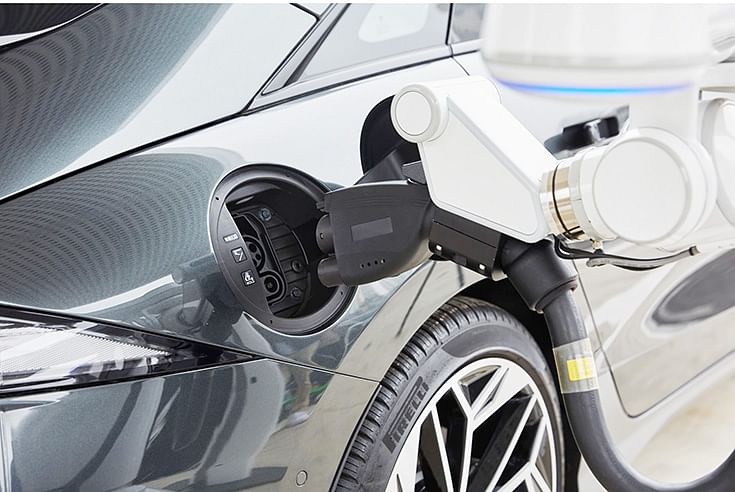Hyundai develops automatic charging robot for EVs
The automatic charging robot correctly plugs the charger into the port using control technology applied by a 3D camera-based artificial intelligence (AI) algorithm
Hyundai Motor Group has developed an automatic charging robot (ACR) for electric vehicles (EVs). The ACR for EVs is a one-arm robot capable of plugging a cable into an EV’s charging port and removing it again once charging is complete.
A video released by the carmaker opens with a scene in which the Hyundai Ioniq 6 parks autonomously in an EV-charging bay. Once the vehicle is stationary, the ACR communicates with the vehicle to open the charging port, calculating the exact location and angle through a camera mounted inside.
The robot then picks up the charger and fastens it to the vehicle’s charging port, thus starting the charging session. Once charging is complete, the robot removes the charger, returns it to its rightful place, and closes the cover of the vehicle’s charging port.
“The ACR will help to make EV-charging easier and more convenient, especially in dark environments. It will also improve accessibility, particularly for people with mobility barriers, as charging cables become thicker and heavier to enable high-speed charging,” said Dong Jin Hyun, Head of Robotics Lab, Hyundai Motor Group. “We will continue developing the ACR for increased safety and more convenience, so that all EV customers can soon benefit from using it at charging stations.”
 Hyundai Motor Group's Robotics Lab considered diverse variables in developing the ACR such as vehicle parking location, shape of charging port, the weather, potential obstacles and the weight of the charging cable.
Hyundai Motor Group's Robotics Lab considered diverse variables in developing the ACR such as vehicle parking location, shape of charging port, the weather, potential obstacles and the weight of the charging cable.
Plugging the tech talk
The ACR, which may appear deceptively simple at first glance, is an example of the Group’s advanced robot technology. The Group’s Robotics Lab has considered diverse variables in developing the ACR, such as the parking location of the vehicle, the shape of the charging port, the weather, potential obstacles and weight of the charging cable.
In order for a robot to fasten a charger to the charging port securely, software technology that can simultaneously calculate these multiple variables is required. To this end, the Group has developed an algorithm that applies 3D camera-based AI technology to robots, and next-generation control technology based on this application allows robots to accurately handle heavy chargers.
Given that that most EV chargers are installed outdoors without cover, the Group’s engineers built a bespoke outdoor electric vehicle charging station at its R&D centre and evaluated performance in various conditions. As a result, the ACR has secured a waterproof and dustproof grade of IP65, and its performance has been greatly improved so that it can be stably operated even in extreme environments. In addition, engineers have installed a safety pole with a built-in laser sensor around the robot to prevent possible accidents by enabling it to detect stationary and moving obstacles.
Hyundai Motor Group expects automatic charging robots to significantly increase convenience of EV charging and, if combined with autonomous parking control systems in future, can improve utilization by sequentially charging several parked vehicles.
The newly unveiled ACR will be on display at Hyundai Motor’s exhibition booth during the 2023 Seoul Mobility Show, held at KINTEX in Ilsan-gu, Goyang-si, Gyeonggi-do, from March 31 to April 9.
RELATED ARTICLES
Horse Powertrain reveals integrated hybrid powertrain
Unit combines Horse Powertrain’s new 1.8-litre ‘HR18’ engine, its DB45S transmission, a 1.4kWh battery, and 50kW 5DH mot...
BMW Group to use natural fibre composites in its future models
Following several years of development and in-depth research, the BMW Group has reached series maturity of natural fibre...
Nissan reinvents Leaf as a sleek electric SUV with 600km range
First launched as a hatchback in 2010, the third-generation Leaf is unrecognisable compared with its predecessors. The n...





 By Autocar Professional Bureau
By Autocar Professional Bureau
 21 Mar 2023
21 Mar 2023
 3742 Views
3742 Views















